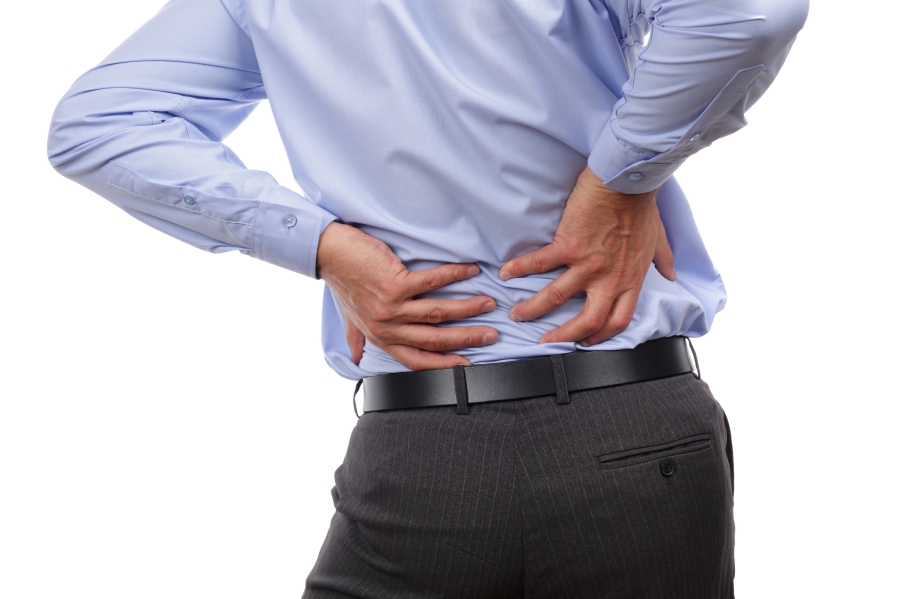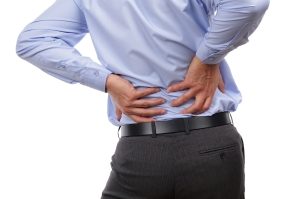Disc Herniation: A Reason to be Worried?


Receiving the diagnosis of a disc herniation or a disc bulge can be daunting and worrisome. After receiving this news, you might have a few questions going through your head. “Will I have to live with this forever?”, “Will it get worse?” or “Do I have to have surgery?” Hopefully, this blog post can help answer some of those concerns by highlighting some incredible research that has come out in regards to disc herniations and lower back pain.
Let’s briefly introduce what occurs in a disc herniation. An intervertebral disc is made up of a central portion (nucleus pulposus) and a bunch of outer layers (anulus fibrosus). Sometimes a tear can occur in the outer layers, and the central portion of the disc protrudes outward along the tear. Depending on the severity of the tear of the outside layers, the central portion can push further out, potentially pressing on the spinal cord or nerves.
There are different kinds of disc herniations. The classification depends on whether or not the central portion of the disc squeezes through the outer layers, and then if it stays connected to the rest of the disc. A disc protrusion can be better thought of as a disc bulge, where the outer layers are still intact, but the central portion may be pushing out on them. A disc extrusion is where the central portion of the disc has broken through the outer layers, but is still connected to the rest of the disc. Lastly, a disc sequestration is where the central portion has leaked through the outer layers, has broken off, and is no longer attached to the rest of the disc.
Medical Research on Disc Herniations
Now that we have discussed what a disc herniation is and the different types, let’s see what the research says about them. First and foremost, disc herniations heal. Well, to be more specific, they commonly go through a phenomenon called spontaneous regression (“unexpected improvement or cure from a disease that usually progresses”). The mechanism behind how this happens is still not very well understood, but according to the 2014 systematic review by Chun-Chieh, et al “The rate of spontaneous regression was found to be 96% for disc sequestration, 70% for disc extrusion, 41% for disc protrusion, and 13% for disc bulging. The rate of complete resolution of disc herniation was 43% for sequestrated discs and 15% for extruded discs.”1 Remember, as we discussed in the previous paragraph, a sequestrated disc is where the central contents have leaked out and are no longer attached to the rest of the disc. According to this study, these types of herniations have a 96% chance to spontaneously regress. So, the more serious the disc herniation is, the better chance it has to heal on its own!
Before we talk about treatment options, we need to discuss when disc herniations and low back pain are more serious in nature. These are things that we, as clinicians, classify as “red flags”. These red flags may indicate something more serious occurring that would warrant further testing, or immediate medical intervention. A few examples of red flags are, but not limited to, persistent pain at night, numbness in the groin region (saddle anesthesia), loss of bladder and bowel function, rapidly progressive neurological deficits, fevers/chills/night sweats, or previous history of cancer.2 It is important to clarify what these red flags are because with low back pain and disc herniations, there is an overabundance of imaging, medication, and surgery. It is normal for people experiencing pain to use imaging to try and find the cause, but evidence shows that image findings are not good predictors of pain. In addition, pain is more complex than that and more aspects of the individual need to be looked at.
Disc Herniations and Imaging
Let’s go into more detail about why findings on images are not good predictors of pain. First of all, pain is more complex than people want to believe. There is a belief that our bodies are like cars. With cars, oftentimes when something is wrong, the check engine light comes on, we take it to a mechanic, the mechanic diagnoses and fixes/replaces the part, and the light goes off. That is not how the human body works, unfortunately. Think of the people you know who have had a low back surgery, maybe a lumbar fusion or a lumbar discectomy (removal of the disc). How many of those people still have back pain? Probably quite a few. But, didn’t the surgery fix the mechanical cause of the pain? Well, it is supposed to, but there are other components that must be considered when exploring why a person has low back pain. Socio-economic and psychological factors are two huge components that are drastically overlooked when an individual is suffering from lower back pain. Individuals who suffer from psychological disorders, such as depression or anxiety, have been shown to experience more chronic pain. In 2008, a population of college students were studied for the association of low back pain and depression. The results showed that “The annual prevalence of LBP among the population studied was 42.8%. The stressful psychosocial variables of feeling very sad, exhausted, and overwhelmed were associated with the prevalence of LBP.”5
Now, let’s bring this conversation back to disc herniations. A study was performed in 2014 by Brinjikji, et al4 that explored lower back image findings of asymptomatic individuals. 3,110 people met their criteria and were included in the study. It is important to point out that these people had never had a single episode of back pain and no traumas to the lower back. What they concluded is that changes to the spine are pretty common and normal. Looking specifically at disc herniations, 50% of 40 year olds have a disc bulge in their lumbar spine. This jumps up 10% each decade the person ages. Furthermore, 88% of 60 year olds have disc degeneration in their lumbar spine.
Let me remind you, these participants didn’t know they had these changes in their low back until the study was done, and they also didn’t have any pain associated with said changes. Let’s say you have a back injury and you suspect a disc herniation has occurred. You go and get an MRI done and it shows that, sure enough, there is a disc herniation in your low back. How do you know if it wasn’t already there? The aforementioned study discounts the idea that all disc herniations, disc bulges, or degenerative disc changes are painful. Therefore, we try to encourage our patients to not get too caught up in image findings, or diagnoses that are based on an image. It can give the patient the narrative that they are broken and need to have surgery to be fixed.
So, what is the best course of action to take in regards to treatment options? A 2020 study posted in the Global Spine Journal determined this: “Results of a retrospective cohort study including almost 280,000 subjects have concluded that prolapsed lumbar intervertebral discs may be successfully managed without the need for surgery in 97% of cases.”3 (A prolapsed disc is just another name for a herniated disc.) Evidence shows that the best way to manage disc herniations are with exercise, patient education, psychological programs, and chiropractic care. Evidence does not suggest rest, ice, injections, pain medication, or surgery. The first group of treatment options are cost effective and empowering, while the second group are expensive and makes the patient reliant on health care providers.
Our Treatment Approach
Our goal at Elite Sport and Spine is to educate our patients on ways they can manage their symptoms through movement and exercise. We encourage our patients to set goals based around activities they like to perform and things that make them happy. An example of this might be an individual who loves to take their dog on a 2 mile walk every day, but due to their recent episode of back pain, they haven’t been able to do so. We want to encourage them to set goals with this task in mind, and build back up to walking their dog 2 miles a day. We recently posted a video on our YouTube page (shown below) that demonstrated an exercise progression that we might use with a patient dealing with disc related low back pain. I would encourage you to watch the video, and if you or someone you know has been dealing with a disc herniation, send it to them. Encourage them to move through ranges of motion that they can tolerate, because this will help them heal faster. As we discussed, rest is not recommended to improve symptoms. We want to work with our patients to find some movement that provides relief, can be performed on their own, and they enjoy. That puts the power in the hands of the patient, instead of the hands of the clinician.
If you or someone you know has been dealing with disc herniations, we would love to help. You can schedule a free consultation online, or call our office at (262) 373-9168.
References:
- Chiu CC, Chuang TY, Chang KH, Wu CH, Lin PW, Hsu WY. The probability of spontaneous regression of lumbar herniated disc: a systematic review. Clin Rehabil. 2015;29(2):184-195. doi:10.1177/0269215514540919
- Foster, Nadine E., et al. “Prevention and Treatment of Low Back Pain: Evidence, Challenges, and Promising Directions.” The Lancet, vol. 391, no. 10137, 2018, pp. 2368–83. Crossref, doi:10.1016/s0140-6736(18)30489-6.
- Lilly DT, Eldridge CM, Singh R, Montgomery EY, Bagley C, Adogwa O. An assessment of non-operative management strategies in a herniated lumbar disc population: successes versus failure. Global Spine J. 2020 Jul 7;2192568220936217. doi: 10.1177/2192568220936217.
- Brinjikji W, Luetmer PH, Comstock B, et al. Systematic literature review of imaging features of spinal degeneration in asymptomatic populations. AJNR Am J Neuroradiol. 2015;36(4):811-816. doi:10.3174/ajnr.A4173
- Kennedy, Catherine & Kassab, Osama & Gilkey, David & Linnel, Sheri & Morris, Debra. (2008). Psychosocial Factors and Low Back Pain Among College Students. Journal of American college health : J of ACH. 57. 191-5. 10.3200/JACH.57.2.191-196.
 262-373-9168
262-373-9168




